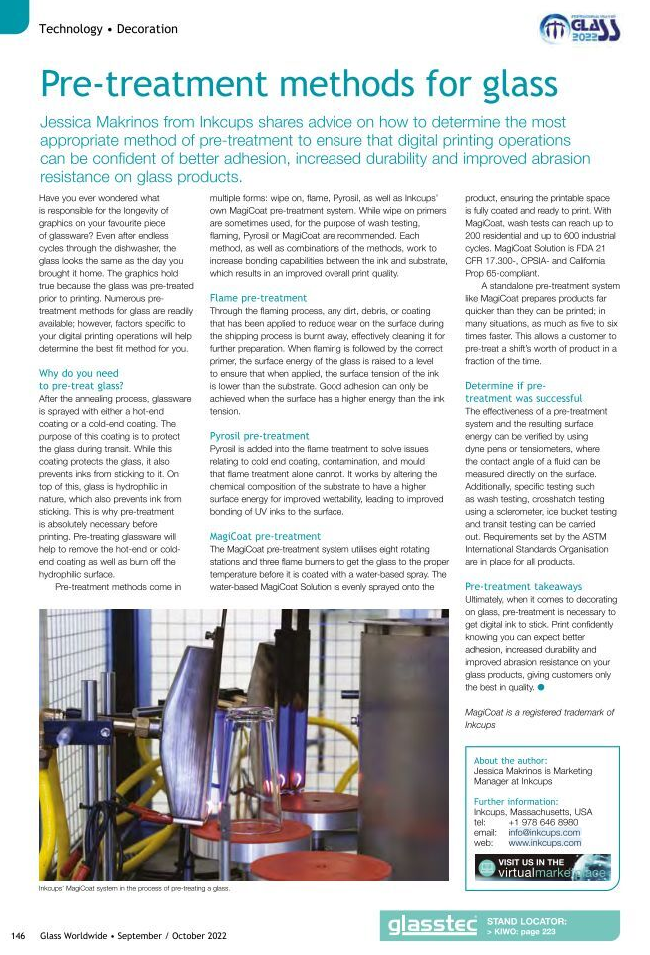- Equipment
- Inks & Supplies
- Services
- Applications
- Tagless
- Resources
- About Us
- Contact Us

This article was published in the September/October issue of Glass Worldwide.
Have you ever wondered what is responsible for the longevity of graphics on your favorite piece of glassware? Even after endless cycles through the dishwasher, the glass looks the same as the day you brought it home. The graphics hold true because the glass was pre-treated prior to printing. Numerous pre-treatment methods for glass are readily available, however factors specific to your digital printing operations will help determine the best fit method for you.
After the annealing process, glassware is sprayed with either a hot-end coating or a cold-end coating. The purpose of this coating is to protect the glass during transit. While this coating protects the glass, it also prevents inks from sticking to it. On top of this, glass is hydrophilic in nature, which also prevents ink from sticking. This is why pre-treatment is absolutely necessary before printing. Pre-treating glassware will help to remove the hot-end or cold-end coating as well as burn off the hydrophilic surface.
Pre-treatment methods come in multiple forms: wipe on, flame, Pyrosil®, as well as MagiCoat™. While wipe on primers are sometimes used, for the purpose of wash testing, flaming, Pyrosil® or MagiCoat™ are recommended. Each method, as well as combinations of the methods, work to increase bonding capabilities between the ink and substrate, which results in an improved overall print quality.
Through the flaming process, any dirt, debris, or coating that has been applied to reduce wear on the surface during the shipping process is burnt away, effectively cleaning it for further preparation. When flaming is followed by the right primer, the surface energy of the glass is raised to a level to ensure that when applied, the surface tension of the ink is lower than the substrate. Good adhesion can only be realized when the surface has a higher energy than the ink tension.
Pyrosil® is added into the flame treatment to solve issues relating to cold end coating, contamination, and mold that flame treatment alone cannot. It works by altering the chemical composition of the substrate to have a higher surface energy for improved wettability, leading to improved bonding of UV inks to the surface.
The MagiCoat™ Pre-Treatment System utilizes eight rotating stations and three flame burners to get the glass to the proper temperature before it is coated with a water-based spray. The water-based MagiCoat™ Solution is evenly sprayed onto the product, ensuring the printable space is fully coated and ready to print. With MagiCoat™, wash tests can reach up to 200 residential and up to 600 industrial cycles. MagiCoat™ Solution is FDA 21 CFR 17.300, CPSIA and California Prop 65 compliant.
A standalone pretreatment system like Magicoat™ prepares products far quicker than they can be printed, in many situations as much as five to six times faster. This allows a customer to pretreat a shift’s worth of product in a fraction of the time.
The effectiveness of a pre-treatment system and the resulting surface energy can be verified by using dyne pens or tensiometers made by companies like Kruss where the contact angle of a fluid can be measured directly on the surface. Additionally, carrying out specific testing such as wash testing, crosshatch testing using a sclerometer, ice bucket testing and transit testing can be done. Requirements set by the ASTM International Standards Organization are in place for all products.
Ultimately, when it comes to decorating on glass, pre-treatment is necessary to get digital ink to stick. Print confidently knowing you can expect better adhesion, increased durability, and improved abrasion resistance on your glass products, giving customers only the best in quality.
Back to Blog Home
Add Your Comment